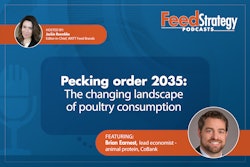
Learning more about how feed ingredients influence the microbial makeup of the poultry gut microbiome could help producers optimize growth, health and performance.
“Understanding the microbiome will help us address industry challenges at a deeper level,” Gilles Houdart, micronutrition & health solutions business director, Cargill Animal Nutrition, said during a September 12 webinar titled “Applying microbiome intelligence to advance monogastric nutrition and health.”
Recognizing the importance of the poultry microbiome
A growing global population and increasing demand for performance emphasize the importance of maximizing poultry growth rates and reproductive performance without compromising health.
The poultry gut microbiome is a relatively new concept. Analyzing its contents can provide insights into how feed additives, other nutrients and management practices positively or negatively impact poultry flock health, helping producers optimize diets for better growth rates, reproduction and overall performance.
“The microbiome has a direct impact on so many functions – nutrient absorption, immune system development, pathogen exclusion, feed efficiency, even environmental impact. Monitoring the microbiota is essential to unlock the full potential of the flock and avoid unnecessary risk,” added Houdart.
Constantly in flux
The makeup of microbes and microorganisms in a microbiome fluctuates constantly and is dependent upon a variety of factors, including the age of the animal, what it eats, if it is given antibiotics, where it lives, stress levels and more.
Focusing on the microbiome earlier in a bird’s life is important. The early establishment of a healthy gut microbiome can result in an animal that is more resilient to health changes and better at preventing pathogen infection.
If a producer knows how certain feed ingredients affect the poultry microbiome, they can adjust the diet to mitigate disease and pathogen risk and improve performance.
“In the past, there was really a one-size-fits-all approach to additives and treatments. But this is changing. Now, it’s all about being more precise and science-based – providing the right product at the right time and in the right amount,” Houdart explained.

















